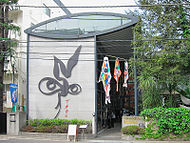- Tarō Okamoto
-
Tarō Okamoto
岡本太郎
Tarō Okamoto in 1953Born 26 February 1911
Kanagawa, JapanDied 7 January 1996 (aged 84) Nationality  Japan
JapanField Painter, Sculpture, Töpfer Movement Nihonga Tarō Okamoto (岡本 太郎 Okamoto Tarō, February 26, 1911 – January 7, 1996) was a Japanese artist noted for his abstract and avant-garde paintings and sculpture.
Biography
He studied at Panthéon-Sorbonne in the 1930s, and created many great works of art after World War II. He was a prolific artist and writer until his death, and has exerted considerable influence on Japanese society.
He was deeply interested in mystery and the occult throughout his years in Paris, where he lived from 1930 to 1940. He majored in ethnology under Professor Marcel Mauss (1872–1950) at the Université Paris Sorbonne and focused on studying the rites among tribes in the zone of Oceania. Okamoto also attended the Collège de Sociologie Sacré organized by George Bataille (1897–1962), and he participated in rites which were carried out in silence and in the darkness of the woods near Saint-Germain in a faubourg of Paris, as a member of Acephale, a secret spiritual society.
He was known for the quote, "Art is Magic" and "Art is Explosion."[citation needed]
Among the artists Okamoto associated with during his stay in Paris were André Breton (1896–1966), the leader of Surrealism, and Kurt Seligmann (1900–62), a Swiss Surrealist artist, who was the Surrealists' authority on magic and who met Okamoto's parents, Ippei and Kanoko Okamoto, during a trip to Japan in 1936.
In the 1950's, he received a commission from the Oriental Nakamura department store in Nagoya to create a large mural on the main facade of their flagship store. The mural was demolished after Oriental Nakamura was bought by Mitsukoshi in the 1970's.
In 1964 Tarō Okamoto published a book titled Shinpi Nihon (Mysteries in Japan). His interest in Japanese mysteries was sparked off by a visit he made to the Tokyo National Museum. After having become intrigued by the Jōmon wares he found there, he journeyed all over Japan in order to research what he perceived as the mystery which lies beneath Japanese culture, and then he published Nihon Sai-hakken-Geijutsu Fudoki (Rediscovery of the Japan-Topography of Art).
One of his most famous works, Tower of the Sun, became the symbol of Expo '70 in Suita, Osaka, 1970. It shows the past (lower part), present (middle part), and future (the face) of the human race. It still stands in the center of the Expo Memorial Park.
After 30 years in Mexico. On November 17, 2008, his mural "The Myth of Tomorrow", depicting a human figure being hit by an atomic bomb, was unveiled in its new permanent location at Shibuya Station, Tokyo. This work was made for the Hotel de Mexico in Mexico city by Manuel Suarez y Suarez.[1]
Kawasaki City, his hometown, has constructed the memorial museum in Tama Ward, northwest of the city.
His studio/home is also open to visitors and is located in Aoyama in Tokyo.
References
- ^ "Instalan en Tokio mural de Okamoto perdido 30 anos en Mexico". (Consultado el 10 de Agosto de 2010.)
External links
- Taro Okamoto Museum of Art, Kawasaki (English)
- Taro Okamoto Memorial Museum (Japanese)
- Gendaigeijyutu Atelier (Japanese)
- Institute of Esthetic Research (Japanese)
- Taro Okamoto's grave (English)
Categories:- 1911 births
- 1996 deaths
- Japanese painters
- Japanese sculptors
- People from Kawasaki (city)
- Tokyo School of Fine Arts alumni
- University of Paris alumni
Wikimedia Foundation. 2010.

